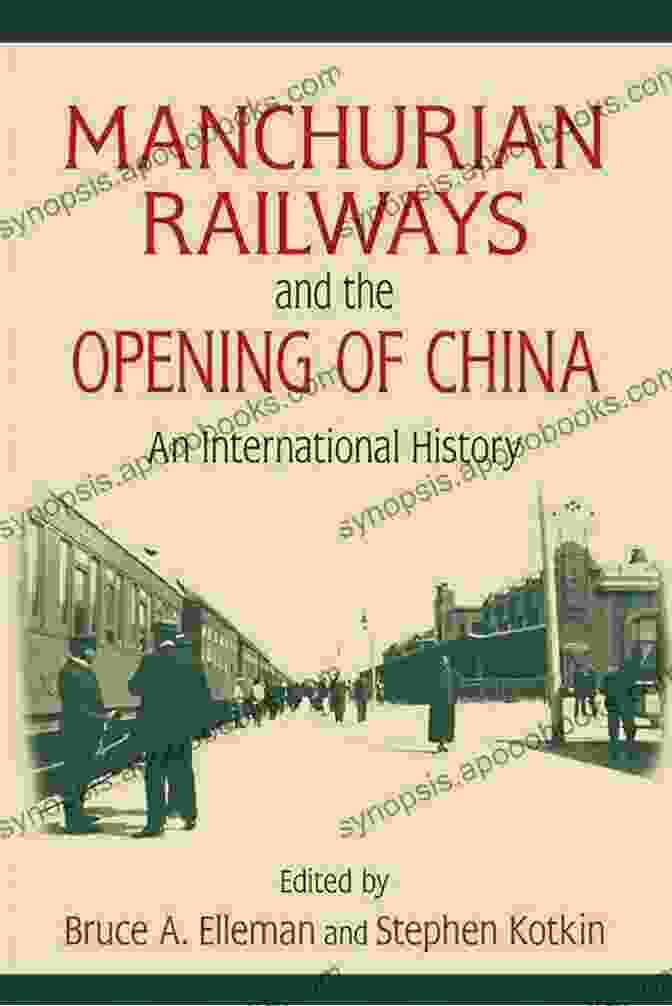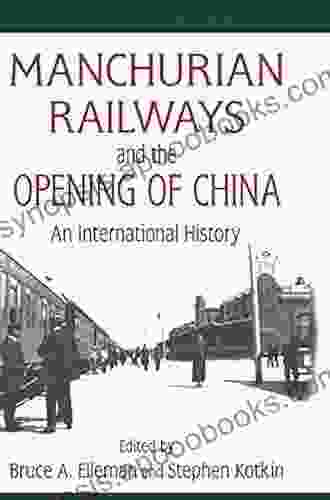Unveiling the Manchurian Railways: A Gateway to Modern China


In the annals of history, the Manchurian Railways played a pivotal role in shaping the destiny of China. From their inception in the late 19th century to their eventual nationalization after World War II, these railroads served as a catalyst for economic development, political turmoil, and international intrigue.
In this comprehensive article, we embark on a journey through the fascinating history of the Manchurian Railways, exploring their impact on China's modernization, the geopolitical tensions they engendered, and the enduring legacy they left on the country.
5 out of 5
| Language | : | English |
| File size | : | 1861 KB |
| Text-to-Speech | : | Enabled |
| Enhanced typesetting | : | Enabled |
| Screen Reader | : | Supported |
| Print length | : | 258 pages |
Genesis: The Birth of the Manchurian Railways
The roots of the Manchurian Railways can be traced to the mid-1890s, when Western powers sought to expand their influence in Northeast Asia. The discovery of rich iron ore deposits in Manchuria sparked a race among Russia, Japan, and Britain to control the region.
In 1896, Russia leased the Liaodong Peninsula from China and began constructing the Trans-Siberian Railway through Manchuria to Vladivostok. Japan, fearing Russian expansionism, responded by securing a lease over the southern half of Manchuria from China in 1905.
With these leases in place, both Russia and Japan rapidly expanded their railway networks in Manchuria. The Russian-owned Chinese Eastern Railway (CER) connected Harbin and Vladivostok, while the Japanese-controlled South Manchurian Railway (SMR) ran from Dalian (Port Arthur) to Changchun.
Economic Engine: The Manchurian Railways and China's Modernization
The construction of the Manchurian Railways had a profound impact on China's economic development. The railways provided efficient transportation for raw materials, agricultural products, and manufactured goods, facilitating trade between Manchuria and the rest of the country.
The SMR, in particular, played a significant role in the industrialization of Manchuria. The Japanese invested heavily in railway infrastructure, coal mining, and other industries, creating a modern economic hub in Northeast China.
The Manchurian Railways also stimulated the development of Chinese industry. The establishment of railway workshops and repair facilities provided opportunities for Chinese engineers and technicians to gain valuable skills. Moreover, the railways created new urban centers and attracted a large influx of labor, fueling the growth of China's industrial workforce.
Political Contests: The Railways and Geopolitical Rivalry
The Manchurian Railways became a focal point of geopolitical rivalry between Russia and Japan. The Russian-owned CER was seen as a threat to Japanese interests in Manchuria, while the SMR was viewed by Russia as a strategic asset for its Siberian expansion.
In 1904, tensions between the two powers erupted into the Russo-Japanese War, which culminated in the Japanese victory and the establishment of Japan's dominance in Manchuria.
The resulting Treaty of Portsmouth in 1905 gave Japan control of the SMR and the Liaodong Peninsula, effectively cementing its influence in the region. However, Russia's continued presence through the CER remained a source of ongoing friction.
Chinese Nationalist Ambitions: The Struggle for Railway Control
As China's nationalist movement gained momentum in the early 20th century, the Manchurian Railways became a symbol of foreign control over Chinese territory. Chinese nationalists demanded the return of railway rights to China, viewing the foreign-owned railroads as an obstacle to their country's independence.
In 1928, the Chinese Nationalist government under Chiang Kai-shek launched the Northern Expedition to unify China and regain control of Manchuria. The Manchurian Railways played a crucial role in the campaign, as control of the railways enabled the Nationalists to transport troops and supplies into the region.
However, Japan's continued presence in Manchuria complicated the situation. The Japanese military viewed the Nationalist government as a threat to their interests in the region and sought to maintain their control over the SMR and the Liaodong Peninsula.
Japanese Invasion and Manchukuo: The Militarization of the Railways
In 1931, the Japanese military launched the Manchurian Incident, which culminated in the invasion and occupation of Manchuria. The Japanese established a puppet state known as Manchukuo, and the SMR became a vital part of the Japanese military machine.
The Manchurian Railways were used to transport troops, supplies, and industrial resources to support Japan's war efforts in China and beyond. The railways also played a role in the Japanese exploitation of Manchuria's natural resources, which were essential for Japan's industrial and military needs.
World War II and the Nationalization of the Manchurian Railways
After Japan's defeat in World War II, the Manchurian Railways were placed under Soviet control. The Soviet Union dismantled the SMR and removed its infrastructure as reparations for Japan's wartime aggression.
In 1950, the People's Republic of China nationalized the remaining sections of the Manchurian Railways. The railways were gradually rebuilt and expanded, becoming a vital part of China's transportation network.
Legacy: The Enduring Impact of the Manchurian Railways
The Manchurian Railways have left an enduring legacy on China. They played a pivotal role in the country's economic modernization, shaped its political landscape, and influenced its international relations.
The Manchurian Railways also symbolized China's struggle for independence and sovereignty. The return of the railways to Chinese control in 1950 was seen as a triumph for Chinese nationalism and a milestone in the country's history.
Today, the Manchurian Railways continue to serve as a major transportation artery in Northeast China. They facilitate trade and economic development, connecting the region to the rest of the country and beyond.
The Manchurian Railways are a testament to the complex and intertwined history of China and Northeast Asia. Their construction, operation, and eventual nationalization shaped the destiny of China, impacting its economy, politics, and international relations.
The Manchurian Railways are a symbol of both China's modernization and its struggle for independence. They stand as a reminder of the country's resilience and determination to reclaim its place in the world.
5 out of 5
| Language | : | English |
| File size | : | 1861 KB |
| Text-to-Speech | : | Enabled |
| Enhanced typesetting | : | Enabled |
| Screen Reader | : | Supported |
| Print length | : | 258 pages |
Do you want to contribute by writing guest posts on this blog?
Please contact us and send us a resume of previous articles that you have written.
 Book
Book Novel
Novel Page
Page Chapter
Chapter Text
Text Story
Story Genre
Genre Reader
Reader Library
Library Paperback
Paperback E-book
E-book Magazine
Magazine Newspaper
Newspaper Paragraph
Paragraph Sentence
Sentence Bookmark
Bookmark Shelf
Shelf Glossary
Glossary Bibliography
Bibliography Foreword
Foreword Preface
Preface Synopsis
Synopsis Annotation
Annotation Footnote
Footnote Manuscript
Manuscript Scroll
Scroll Codex
Codex Tome
Tome Bestseller
Bestseller Classics
Classics Library card
Library card Narrative
Narrative Biography
Biography Autobiography
Autobiography Memoir
Memoir Reference
Reference Encyclopedia
Encyclopedia Claudia Milian
Claudia Milian Elvis Santino
Elvis Santino Paul Schmitz
Paul Schmitz Colin Alexander
Colin Alexander Claudio Ceni
Claudio Ceni Lan Dong
Lan Dong Suketu Mehta
Suketu Mehta Curtis Wilkie
Curtis Wilkie Dan Ariely
Dan Ariely Concepcion Molina
Concepcion Molina Lisa Johnson Mandell
Lisa Johnson Mandell Clifford Mayes
Clifford Mayes Cyndi Smasal
Cyndi Smasal Ralph Waldo Emerson
Ralph Waldo Emerson David Revill
David Revill Curt Vevang
Curt Vevang Cory Mccarthy
Cory Mccarthy Cosmopolitan
Cosmopolitan Tony Conniff
Tony Conniff Courtney Walsh
Courtney Walsh
Light bulbAdvertise smarter! Our strategic ad space ensures maximum exposure. Reserve your spot today!

 Giovanni MitchellPossession and Comparative Anatomy of the Psyche: A Journey into the Depths...
Giovanni MitchellPossession and Comparative Anatomy of the Psyche: A Journey into the Depths...
 Danny SimmonsBlack Site: Delta Force Novel - An Explosive Thriller That Will Keep You on...
Danny SimmonsBlack Site: Delta Force Novel - An Explosive Thriller That Will Keep You on...
 Jaylen MitchellUnlock the Enchanting World of Tenor Guitar with the Hal Leonard Tenor Guitar...
Jaylen MitchellUnlock the Enchanting World of Tenor Guitar with the Hal Leonard Tenor Guitar... Henry JamesFollow ·9.3k
Henry JamesFollow ·9.3k John SteinbeckFollow ·16.8k
John SteinbeckFollow ·16.8k Ken SimmonsFollow ·18.1k
Ken SimmonsFollow ·18.1k Ray BlairFollow ·7.1k
Ray BlairFollow ·7.1k Kazuo IshiguroFollow ·19.2k
Kazuo IshiguroFollow ·19.2k Roald DahlFollow ·15.1k
Roald DahlFollow ·15.1k Alec HayesFollow ·18.4k
Alec HayesFollow ·18.4k Thomas PynchonFollow ·15.1k
Thomas PynchonFollow ·15.1k

 Cooper Bell
Cooper BellKids Rule Box Office Hits for the Elementary Player
Empowering Young Performers:...

 Gabriel Blair
Gabriel BlairUnraveling the Enigma: Political Alienation and Its...
In the labyrinthine tapestry of human...

 Anthony Burgess
Anthony BurgessBe a Great Singer: Unleash Your Musical Talent with...
Do you dream of singing with...

 Heath Powell
Heath PowellDive into a Musical Masterpiece: "10 for 10 Sheet Music...
An Enchanting Journey Through Broadway...

 Guy Powell
Guy PowellUniversal Rights, Systemic Violations, and Cultural...
The notion of universal human rights is a...
5 out of 5
| Language | : | English |
| File size | : | 1861 KB |
| Text-to-Speech | : | Enabled |
| Enhanced typesetting | : | Enabled |
| Screen Reader | : | Supported |
| Print length | : | 258 pages |








